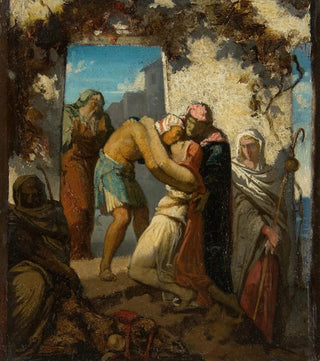Art print | A scene from the story of Tobit - Henri Lehmann


View from behind

Frame (optional)
The artwork "A Scene from the Story of Tobit" by Henri Lehmann is a true invitation to immerse oneself in the rich and complex universe of biblical narratives. This painting, which highlights a key moment in the story of Tobit, evokes universal themes such as faith, redemption, and divine providence. Through a carefully orchestrated composition, Lehmann manages to capture the essence of this ancient story while situating it within a 19th-century artistic context. The piece, both timeless and deeply rooted in its era, invites viewers to reflect on the meaning of humanity and the quest for light in darkness.
Style and uniqueness of the artwork
Henri Lehmann's style is distinguished by his ability to blend realism with a certain idealization of human figures. In "A Scene from the Story of Tobit," the characters are rendered with meticulous precision, their expressions and postures conveying intense emotions. The color palette chosen by the artist is both rich and nuanced, playing with shadows and highlights to create an atmosphere that is both dramatic and soothing. The details, whether in the characters' clothing or the elements of the setting, demonstrate a concern for realism that does not sacrifice the poetic dimension of the scene. Lehmann thus succeeds in establishing a balance between visual storytelling and aesthetic beauty, making this work a true masterpiece of its time.
The artist and his influence
Henri Lehmann, an emblematic figure of the neo-classical movement, established himself as a master of history painting. Trained at the École des Beaux-Arts in Paris, he was influenced by the great masters of the Renaissance and Baroque, while developing a distinctive style that set him apart. His work is marked by a constant pursuit of historical truth and a desire to convey moral values through his creations. Lehmann also played an important role in art education, passing on his knowledge to many students who would continue his quest for excellence. His impact on 19th-century French art is undeniable.

Matte finish

View from behind

Frame (optional)
The artwork "A Scene from the Story of Tobit" by Henri Lehmann is a true invitation to immerse oneself in the rich and complex universe of biblical narratives. This painting, which highlights a key moment in the story of Tobit, evokes universal themes such as faith, redemption, and divine providence. Through a carefully orchestrated composition, Lehmann manages to capture the essence of this ancient story while situating it within a 19th-century artistic context. The piece, both timeless and deeply rooted in its era, invites viewers to reflect on the meaning of humanity and the quest for light in darkness.
Style and uniqueness of the artwork
Henri Lehmann's style is distinguished by his ability to blend realism with a certain idealization of human figures. In "A Scene from the Story of Tobit," the characters are rendered with meticulous precision, their expressions and postures conveying intense emotions. The color palette chosen by the artist is both rich and nuanced, playing with shadows and highlights to create an atmosphere that is both dramatic and soothing. The details, whether in the characters' clothing or the elements of the setting, demonstrate a concern for realism that does not sacrifice the poetic dimension of the scene. Lehmann thus succeeds in establishing a balance between visual storytelling and aesthetic beauty, making this work a true masterpiece of its time.
The artist and his influence
Henri Lehmann, an emblematic figure of the neo-classical movement, established himself as a master of history painting. Trained at the École des Beaux-Arts in Paris, he was influenced by the great masters of the Renaissance and Baroque, while developing a distinctive style that set him apart. His work is marked by a constant pursuit of historical truth and a desire to convey moral values through his creations. Lehmann also played an important role in art education, passing on his knowledge to many students who would continue his quest for excellence. His impact on 19th-century French art is undeniable.






